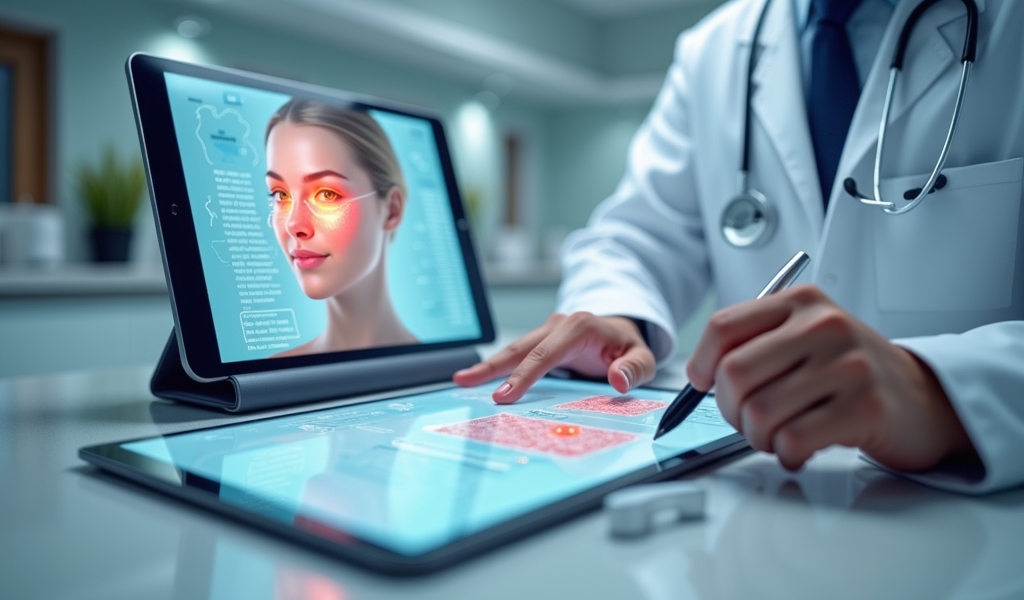Overview
Virtual dermatology provides seven essential benefits: unparalleled convenience, faster access to care, enhanced privacy, cost-effectiveness, expanded access to specialists, efficient ongoing monitoring, and complementary integration with in-person care. This digital approach to skin care has transformed dermatological treatment by removing traditional barriers while maintaining high-quality care, making it an increasingly popular and effective healthcare delivery model that connects patients with expert dermatologists regardless of location.
Table of Contents
- 1. Unparalleled Convenience
- 2. Faster Access to Care
- 3. Privacy and Comfort
- 4. Cost-Effectiveness
- 5. Expanded Access to Specialists
- 6. Ongoing Monitoring and Support
- 7. Complementary to In-Person Care
- The Future of Skin Care Is Here
- Frequently Asked Questions
In an era where digital solutions have transformed how we shop, work, and connect, healthcare is experiencing its own digital revolution. Telemedicine has emerged as a powerful healthcare delivery model, with virtual dermatologist services becoming increasingly popular among patients seeking skin care solutions. The convenience and effectiveness of online dermatology consultations provide patients with quality skin care without the traditional barriers of in-person visits.
According to the American Academy of Dermatology, teledermatology has proven to be highly effective for diagnosing and treating numerous skin conditions. Let’s explore the seven essential benefits that make virtual dermatology a game-changer for patients nationwide.
1. Unparalleled Convenience
The most immediate advantage of a virtual dermatologist is the remarkable convenience it offers. Rather than arranging your day around a doctor’s appointment, virtual consultations allow you to meet with a dermatologist from anywhere – your home, office, or even while traveling. This eliminates commute time, parking hassles, and those notorious waiting room delays.
Many patients particularly appreciate the flexible scheduling options. Virtual appointments can often be booked outside traditional office hours, making it easier to fit skin care into busy schedules. This convenience factor alone has transformed how many people approach their dermatological care, making regular skin check-ups more accessible than ever before.
Furthermore, scheduling a virtual doctor visit for skin concerns typically takes just minutes online, compared to the phone calls and potential hold times associated with traditional appointments.
2. Faster Access to Care
When you’re dealing with a concerning rash, sudden acne flare-up, or suspicious mole, waiting weeks for an appointment can be both frustrating and anxiety-inducing. Virtual dermatology significantly reduces these wait times. While traditional in-person dermatology appointments might take weeks or even months to secure, online consultations can often be scheduled within days or sometimes even hours.
This expedited access is especially valuable for conditions requiring prompt attention. Virtual dermatologists can quickly assess urgent skin concerns, providing immediate guidance and, if necessary, prescriptions. Similarly, follow-up appointments to monitor treatment progress happen much more efficiently through virtual platforms, ensuring your skin care remains consistent and responsive.

3. Privacy and Comfort
Skin conditions can be deeply personal and sometimes embarrassing for patients to discuss. Virtual dermatology creates a safe space where patients can discuss sensitive skin issues from the comfort and privacy of their own homes. This familiar environment often reduces the anxiety many people experience in clinical settings.
Without the exposure of sitting in a waiting room or encountering other patients, virtual consultations offer a level of discretion that many find reassuring. Patients frequently report feeling more at ease discussing conditions like acne, psoriasis, or eczema when they’re in their own space, leading to more open conversations and ultimately better care outcomes.
Additionally, the ability to have a video doctor visit with a dermatologist means patients can show their skin concerns in real-time without the discomfort of an in-person examination.
4. Cost-Effectiveness
The financial benefits of virtual dermatology are substantial. Online consultations typically cost less than in-person visits, making specialized skin care more affordable. Beyond the direct consultation fees, patients save on associated expenses like gas, parking, and potentially lost wages from taking time off work.
According to a study published in JAMA Dermatology, patients who utilized teledermatology services saved an average of 2.5 hours of work time per visit compared to in-person appointments, translating to significant indirect cost savings.
Most insurance providers now recognize and cover telemedicine services, including virtual dermatology. There are also transparent payment options for those without insurance coverage. This cost-effectiveness removes financial barriers that might otherwise prevent people from seeking the dermatological care they need.
5. Expanded Access to Specialists
Geography should never determine the quality of healthcare you receive. Virtual dermatology eliminates geographical limitations, connecting patients with specialists regardless of location. This is particularly valuable when dealing with rare skin conditions that require expertise not available locally.
For patients in rural or underserved areas, this expanded access can be transformative. Instead of traveling hours to see a qualified dermatologist, these patients can connect with experts through their smartphones or computers. Networks of virtual dermatologists often include specialists in various skin conditions, ensuring you receive the most appropriate care for your specific needs.
The benefits of expanded access include:
- Access to dermatologists with specialized expertise in rare conditions
- Elimination of travel barriers for patients with mobility issues
- Options to consult with multiple specialists for complex cases
- Reduced healthcare disparities in underserved communities

6. Ongoing Monitoring and Support
Managing chronic skin conditions requires consistent monitoring and adjustment of treatment plans. Virtual dermatology excels in this area, offering streamlined ways to track progress and manage medications. Patients can easily share high-quality photos of their skin over time, allowing dermatologists to document changes and adjust treatments accordingly.
Digital platforms also facilitate medication management, with electronic prescriptions and refill reminders. Regular virtual check-ins, which might be just 10-15 minutes, provide continuous support without requiring full appointments. This consistent care model leads to better adherence to treatment plans and improved outcomes for patients with long-term skin conditions.
Consider these advantages for ongoing care:
- Easy submission of progress photos between appointments
- Quick access to your dermatologist for unexpected reactions or concerns
- Streamlined prescription management
- Consistent monitoring without disrupting your schedule
7. Complementary to In-Person Care
Virtual dermatology isn’t about replacing traditional care but enhancing it. The most effective approach often combines both virtual and in-person elements. Initial screenings can occur virtually, determining which patients need physical examinations or procedures. This hybrid approach optimizes both the patient’s time and the dermatologist’s resources.
Following in-person treatments or procedures, virtual follow-ups offer a convenient way to monitor recovery and results without unnecessary office visits. Online doctor visits seamlessly coordinate with in-person care when needed, ensuring comprehensive management of all skin conditions.
This integrative approach provides significant advantages:
- Initial assessment and triage through virtual platforms
- Focused in-person visits for procedures or complex examinations
- Virtual post-procedure follow-ups
- Continuous care between physical appointments
The Future of Skin Care Is Here
The seven benefits we’ve explored—convenience, faster access, privacy, cost-effectiveness, specialist access, ongoing monitoring, and complementary care—demonstrate why virtual dermatology has become an essential component of modern skin care. As technology continues to advance, with better cameras, AI-assisted diagnostics, and more intuitive platforms, the virtual dermatologist experience will only improve.
Research from the Centers for Disease Control and Prevention indicates that telehealth adoption has accelerated dramatically, with patient satisfaction rates consistently high for virtual dermatology services.
Whether you’re dealing with acne, eczema, psoriasis, suspicious moles, or just need routine skin checks, experienced virtual dermatologists are ready to provide the care you need—no matter where you are. The future of dermatology is increasingly digital, offering unprecedented access to quality skin care for all patients.
Ready to experience the benefits of a virtual dermatologist? Consider scheduling your first online consultation to see how this modern approach to skin care can fit your lifestyle and health needs. Your skin deserves expert care, and now it’s more accessible than ever before through virtual dermatology services.
Frequently Asked Questions
What skin conditions can be treated by a virtual dermatologist?
Virtual dermatologists can effectively diagnose and treat a wide range of skin conditions including acne, eczema, psoriasis, rosacea, suspicious moles, rashes, hives, fungal infections, and hair loss. While some conditions may eventually require in-person assessment, the majority of common skin issues can be initially evaluated and often completely managed through virtual consultations.
How does a virtual dermatologist examination work?
During a virtual dermatology appointment, you’ll connect with the dermatologist via secure video conferencing. You’ll discuss your symptoms, medical history, and concerns. The dermatologist will ask you to show the affected areas using your camera. You may be asked to submit high-quality photos before or during the appointment. Based on this visual examination and your history, the dermatologist will provide a diagnosis, treatment plan, and prescriptions if necessary.
Are prescriptions from virtual dermatologists valid at all pharmacies?
Yes, prescriptions from licensed virtual dermatologists are just as valid as those from in-person visits. These prescriptions can be filled at any pharmacy, and many virtual dermatology platforms offer electronic prescription services that send your prescription directly to your preferred pharmacy. Some services even offer mail-order options for greater convenience.
Does insurance cover virtual dermatologist appointments?
Many insurance plans now cover virtual dermatology consultations, especially since the COVID-19 pandemic accelerated telehealth adoption. Coverage varies by insurance provider and plan type. Medicare and most major private insurers have expanded their telehealth coverage. It’s always best to check with your specific insurance provider about coverage details before scheduling an appointment.
What equipment do I need for a successful virtual dermatologist appointment?
For a productive virtual dermatology appointment, you’ll need a device with a camera (smartphone, tablet, or computer with webcam), a stable internet connection, and good lighting. Natural daylight is ideal for showing skin conditions accurately. You may also want to have a flashlight handy to illuminate areas that are difficult to see. Some dermatologists recommend having a friend or family member available to help position the camera for hard-to-reach areas like your back or scalp.

